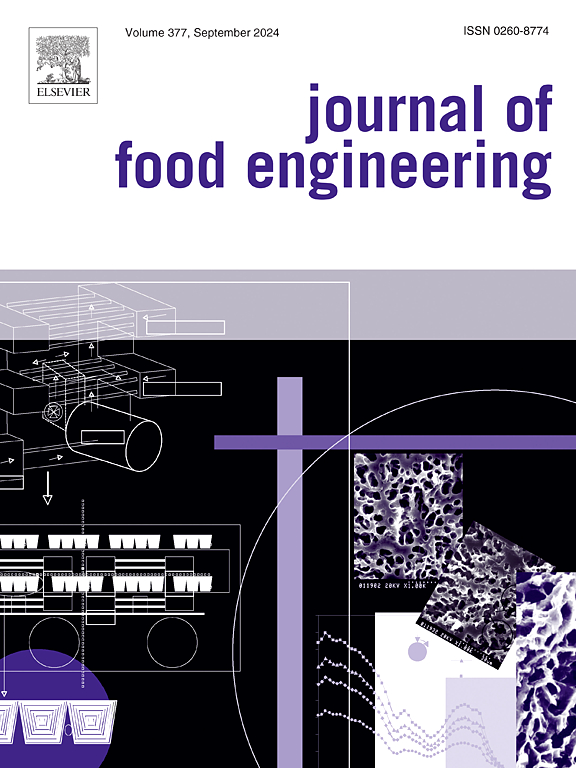Tailoring functional properties of gum Arabic and partially hydrolyzed guar gum-based delivery systems for phenylethanoid glycosides from Mountain Germander (Teucrium montanum L.)
IF 5.8
2区 农林科学
Q1 ENGINEERING, CHEMICAL
引用次数: 0
Abstract
The growing popularity of plant extracts as valuable sources of bioactive compounds is clearly reflected in the investment in technological solutions that ensure stability and more convenient integration into food formulations. The aim of this study was to investigate the effect of secondary polymers - hydrolyzed collagen (COL), kappa-carrageenan (CAR) and carboxymethylcellulose (CMC) on the physico-chemical and functional properties of spray-dried microparticles based on gum Arabic (GA) and partially hydrolyzed guar gum (GG) for the delivery of phenylethanoid glycosides from Mountain Germander extract. The viscoelastic properties of the feed solutions as well as the physico-chemical, bioactive and thermal properties of the MG microparticles were determined for all formulations. Improved electrostatic repulsion was observed for the GA_CAR and GG_CMC formulations. The addition of CMC improved the surface morphology and reduced the wettability of the microparticles, thus providing controlled release of the PhG. The ATR-FTIR spectra revealed high affinity of the PhG to interact with polar functional groups of examined carrier matrices. The introduction of COL into the GA solution as well as CMC into the GG solution significantly (p < 0.05) reduced the encapsulation efficiency by max. 25 %, depending on the PhG compound analyzed. The results of this study reveal the suitability of GA and GG for the retention of PhG as well as the emerging potential of CMC for modifying the functional properties of the hydrophilic carrier matrix.
阿拉伯胶和部分水解瓜尔胶基德山苯乙醇苷递送系统的裁剪功能特性
植物提取物作为有价值的生物活性化合物来源的日益普及,清楚地反映在技术解决方案的投资上,以确保稳定性和更方便地整合到食品配方中。研究了水解胶原蛋白(COL)、kappa- carragean (CAR)和羧甲基纤维素(CMC)等二级聚合物对以阿拉伯胶(GA)和部分水解瓜尔胶(GG)为基础的喷雾干燥微颗粒的理化性质和功能特性的影响。测定了所有配方的饲料溶液的粘弹性以及MG微粒的物理化学、生物活性和热性能。GA_CAR和GG_CMC配方的静电斥力有所改善。CMC的加入改善了表面形貌,降低了微颗粒的润湿性,从而提供了PhG的可控释放。ATR-FTIR光谱显示PhG与所检查的载体矩阵的极性官能团相互作用具有高亲和力。在GA溶液中引入COL,在GG溶液中引入CMC,效果显著(p <;0.05)最大限度地降低了封装效率。25%,取决于所分析的PhG化合物。本研究的结果揭示了GA和GG对PhG保留的适用性,以及CMC在修饰亲水性载体矩阵的功能特性方面的新兴潜力。
本文章由计算机程序翻译,如有差异,请以英文原文为准。
求助全文
约1分钟内获得全文
求助全文
来源期刊

Journal of Food Engineering
工程技术-工程:化工
CiteScore
11.80
自引率
5.50%
发文量
275
审稿时长
24 days
期刊介绍:
The journal publishes original research and review papers on any subject at the interface between food and engineering, particularly those of relevance to industry, including:
Engineering properties of foods, food physics and physical chemistry; processing, measurement, control, packaging, storage and distribution; engineering aspects of the design and production of novel foods and of food service and catering; design and operation of food processes, plant and equipment; economics of food engineering, including the economics of alternative processes.
Accounts of food engineering achievements are of particular value.
 求助内容:
求助内容: 应助结果提醒方式:
应助结果提醒方式:


